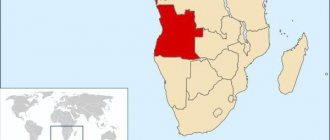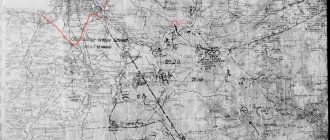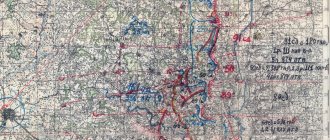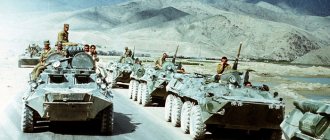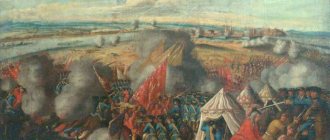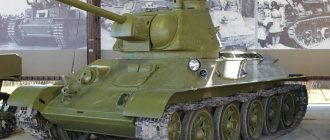Causes and essence of the conflict
The main culprits in starting a new war were Germany, Italy and Japan.
All these countries were late to share the so-called “colonial pie” and sought to redraw the political map of the world in their favor. Despite the fact that Japan and Italy emerged victorious from the First World War, they never received the required results - the main colonies and markets remained in the hands of the main colonial powers: Great Britain, France and the USA. Germany, as the losing side, was forced to accept the difficult conditions of the Versailles Peace Treaty. All this paved the way for a new world war. There were other reasons for the conflict. Thus, in 1931, Japan occupied Northern China and Manchuria, and in 1937, the Sino-Japanese War began, which lasted until Japan’s surrender in 1945.
Japan's economic and military expansion in China met with active resistance from its main competitors in the region: Great Britain and the United States, which imposed economic sanctions against it.
In 1938, on Lake Khasan, and in 1939, on the Khalkhin Gol River, a series of border armed clashes took place between the USSR and Japan.
Japanese occupation in China
The fascists, led by Benito Mussolini, who came to power in Italy in 1922, began to pursue an increasingly aggressive foreign policy in the 1930s. In 1935 they declared war on Ethiopia and captured its territory in 1936. At the same time, the “Greater Italy” project was published, according to which the Mediterranean Sea was declared a sphere of interest for Italy.
Huge indemnities and economic sanctions from the victorious countries, as well as the severe economic crisis that broke out in 1929, hit the German economy hard. Poverty, unemployment and social inequality led to the fact that radical nationalist parties began to gain popularity in Germany.
In 1933, the National Socialist German Workers' Party (NSDAP), led by Adolf Hitler, came to power in Germany. Some of the main slogans of the Nazi Party were the abolition of the terms of the Versailles Peace Treaty, revanchism and the expansion of living space for the German nation.
In 1933, Germany withdrew from the League of Nations. In 1935, Germany introduced universal conscription and began a rapid build-up of military power. From 1934 to 1940, military production increased 22 times.
With the connivance of the Western powers and the League of Nations, German troops were sent into the demilitarized Rhineland in 1936, and in 1938 the Anschluss of Austria was carried out without resistance.
In their desire to pacify the aggressor and direct his appetites to the east, Great Britain and France made more and more concessions to Germany.
Seeing that his actions were not met with active opposition, Hitler issued an ultimatum to Czechoslovakia to transfer the Sudetenland, populated predominantly by Germans, to Germany. On September 30, 1938, the Munich Agreement
(in Soviet historiography known as the “Munich Agreement”), according to which the Sudetenland was transferred to Germany. The Czechoslovak delegation was not present and was presented with a fact. The phrase uttered by British Prime Minister Neville Chamberlain upon his return to London became famous: “I brought peace to our generation.” Winston Churchill reacted to this with the words: “Great Britain was offered a choice between war and dishonor. She chose dishonor and will get war.”
Chamberlain after arriving from Munich
In violation of the Munich Agreement, in March 1939, Germany occupied the remaining part of the Czech Republic, creating the Protectorate of Bohemia and Moravia on its territory, and Slovakia was declared a formally independent pro-Nazi state.
Partition of Czechoslovakia under the Munich Agreement
In the spring of 1939, the USSR proposed that Great Britain and France conclude a trilateral agreement on mutual assistance in the event of German aggression, but was refused. Seeing the reluctance of Western countries to enter into an alliance, Moscow signed a non-aggression pact with Berlin on August 23, 1939, which became known as the Molotov-Ribbentrop Pact
and included a secret protocol on the delimitation of spheres of influence in Eastern Europe.
Countries that took part in World War II
Participants in the war can be divided into two opposing camps: the Axis countries with their allies and the countries of the anti-Hitler coalition.
During the war, the number of participating countries changed depending on the success of one side or another. To the Axis
These included primarily Germany, Italy and Japan, which signed the Tripartite Pact on mutual assistance and distribution of zones of influence on September 27, 1940. Also their allies were Hungary, Romania, Bulgaria, Finland and the collaborationist governments of the countries conquered by Germany, Italy and Japan.
The main participants in the anti-Hitler coalition
Initially, the first to enter the war with Germany were Great Britain (with the dominions), France and Poland, and since 1941 - the USSR, the USA and China.
Europe on the eve of war
The main stages of the events of World War II
First stage of World War II (September 1939 - June 1941)
On the morning of September 1, 1939
The German battleship Schleswig-Holstein attacked Polish fortifications on Westerplatte near Gdansk, thus starting World War II.
Schleswig-Holstein attack on Polish positions
Hitler called the seizure of the radio station in Gleiwitz by the Poles as a pretext for the outbreak of hostilities, which turned out to be a provocation of the SS.
September 3
Great Britain and France declared war on Germany.
Having a multiple advantage in the number of troops, armored vehicles and aviation, the Wehrmacht, despite the fierce resistance of the Polish troops, by September 10
defeated the main armed forces of Poland.
September 17
units of the Workers 'and Peasants' Red Army (RKKA) entered the territory of Eastern Poland to “protect fraternal peoples” - the territories of Western Belarus and Western Ukraine became part of the USSR under the secret protocol to the Molotov-Ribbentrop Pact. On the same day, the Polish government fled the country.
September 28
Warsaw was captured by German troops, and
on October 6
the last resisting units of the Polish army surrendered.
Despite promises of assistance to Poland in the event of German aggression, France and Great Britain never began active hostilities on the Western Front, which protected Germany from a war on two fronts. The inaction of the allied forces was called the “strange war”
.
Polish Wehrmacht campaign
From the beginning of hostilities, Germany carried out a large-scale submarine war against Great Britain, destroying a third of its merchant fleet by the summer of 1941
In an effort to secure Leningrad from the north-west, the Soviet Union offered Finland to exchange part of the Karelian Isthmus for twice the territory in Karelia, but was refused.
November 30, 1939
The Soviet-Finnish war began.
After bloody battles and heavy losses, by the beginning of March 1940, Soviet troops managed to break through the “Mannerheim Line” (a complex of defensive structures between the Gulf of Finland and Ladoga, 132–135 km long, created in 1920–1930 on the Finnish part of the Karelian Isthmus to deter a possible offensive attack from the USSR)
, and on March 13 a peace treaty was signed.
Acquisitions of the USSR following the results of the Soviet-Finnish war
The aggression of the Soviet Union led to its exclusion from the League of Nations and a cooling of relations with Western countries.
April 9, 1940
Germany occupied Denmark and invaded Norway. The last units of the Norwegian armed forces surrendered on June 10.
May 10
German troops through the territories of Luxembourg, the Netherlands and Belgium, with a rapid offensive of tank and mechanized formations, broke through the Allied defenses and by May 20 reached the English Channel. The British Expeditionary Force and part of the French army managed to evacuate through Dunkirk, abandoning huge amounts of artillery and armored vehicles.
Allied evacuation from Dunkirk
June 14
Wehrmacht units entered Paris without meeting resistance.
And on June 22, France capitulated. Most of it was occupied, and on the territory not occupied by German troops, a pro-fascist government was formed under the leadership of Marshal Pétain ( Vichy government
).
French Wehrmacht campaign
June 10th
Italy entered the war, occupying British Somalia, part of Kenya and Sudan.
Summer 1940
With the active participation of the Soviet Union, elections were held in Lithuania, Latvia and Estonia. The victorious pro-Soviet forces proclaimed the creation of socialist republics and were accepted into the USSR in August.
In August
The so-called Battle of Britain began - systematic bombing by the
Luftwaffe (Wehrmacht Air Force during the Third Reich)
of English cities, as well as industrial and military facilities. By May 1941, the intensity of bombing had decreased due to the transfer of the main forces of the German Air Force to the east for the upcoming attack on the USSR.
In February 1941
Wehrmacht units under the command of Erwin Rommel were sent to North Africa to capture Egypt.
In the spring of 1941, German troops occupied Yugoslavia and Greece. As a result of the first period of the war, Germany and its allies captured almost all of Europe, the military and economic potential of which was used for the upcoming war with the USSR.
Europe on the eve of June 22, 1941
Second stage of World War II (June 1941 - November 1942)
On the morning of June 22, 1941
Without a declaration of war, German troops invaded the territory of the Soviet Union.
This event is considered to be the beginning of the second stage of World War II. According to Plan Barbarossa,
Germany launched a strike with three army groups along the entire western border of the USSR. The surprise of the attack led to large losses of military equipment, ammunition and aircraft.
On June 22-24, the USA and Great Britain expressed support for the USSR and began to develop agreements on military-economic cooperation. The anti-Hitler coalition began to take shape.
People listen to Molotov's message on the radio about the beginning of the war
Despite fierce resistance and constant attempts at counterattacks, Wehrmacht units quickly advanced deep into Soviet territory.
8 September
The German Army Group North closed the encirclement ring around Leningrad - the
blockade
of the city began, which lasted
872
days and claimed the lives of hundreds of thousands of civilians.
By November 1941
Army Group South captured almost all of Ukraine and Rostov-on-Don was captured on November 21.
But Army Group Center's advance on Moscow was stopped. On December 5, the Red Army launched a counteroffensive, and German forces were driven back from the capital 100–250 km to the west. The plan for a lightning war was thwarted.
Soviet counteroffensive near Moscow
December 7, 1941
Japanese aircraft attacked the American naval base at Pearl Harbor in Hawaii. The surprise attack neutralized the American Pacific Fleet for six months, allowing Japan to capture most of Southeast Asia.
Attack on Pearl Harbor
Summer 1942
After the unsuccessful offensive operation of Soviet troops near Kharkov, the southern part of the front was weakened. The Wehrmacht command decided to deliver the main blow in this direction in order to seize the Caucasian oil fields.
On July 17, the Battle of Stalingrad began.
By the end of autumn, Wehrmacht units managed to occupy Kuban, but they were stopped in the Caucasus and near Novorossiysk. Near Stalingrad, the Soviet command concentrated forces to launch a counteroffensive.
The situation on the Eastern Front by November 1942
In the Pacific theater of operations, after the battles at Midway Atoll and for the island of Guadalcanal, Japan exhausted its forces and went on the defensive.
In North Africa, Italian-German troops were defeated in Egypt, and American-British troops that landed in French North Africa began an attack on Tunisia from Algeria.
Third stage of World War II (November 1942 - June 1944)
November 19, 1942
Soviet troops launched a counteroffensive near Stalingrad, encircling a 300,000-strong group of fascist troops under the command of Field Marshal Friedrich Paulus, which marked the beginning of the third stage of World War II. German attempts to release the 6th Army failed. As a result, over 90 thousand soldiers and officers, as well as 24 generals and Field Marshal Paulus, were captured. The Wehrmacht troops had never experienced such a defeat.
Summer 1943
The German command made a last attempt to seize the initiative with an offensive near Kursk. But after fierce fighting that lasted a month and a half, the Germans no longer thought about offensive operations, turning to the defensive.
The Germans' hope that the Soviet offensive could be stopped on the Dnieper collapsed after it was crossed by Soviet troops and Kyiv was liberated.
By mid-1944
Almost the entire territory of Ukraine was liberated.
January 27, 1944
The blockade of Leningrad was finally lifted.
In Tunisia, American-British troops defeated the Germans and on July 10, 1943
landed in Sicily, and
in September
- in the south of the Apennine Peninsula.
The defeats of the Italian troops led to the decision of the King of Italy, Victor Emmanuel III, to arrest Mussolini. The new government, led by Marshal Badoglio, signed an armistice with the allies on September 3. In response, German troops occupied northern Italy.
By the end of 1943
the turning point in the war became obvious.
Therefore, from November 28 to December 1, 1943, a meeting of the so-called “Big Three”
: Joseph Stalin, Franklin Delano Roosevelt and Winston Churchill.
The goals of the conference were to develop a general plan for the fight against Germany and its allies, the issue of opening a second front
in France, the USSR's entry into the war with Japan, the post-war structure of the world, and others.
From left to right: Stalin, Roosevelt, Churchill
The fourth stage of the war (June 1944 - September 1945)
June 6, 1944
the allies, according to the promises made in Tehran, opened
a second front
in Europe.
The Normandy landings
became the largest amphibious operation in human history.
Landing in Normandy
25-th of August
Paris was liberated. By the end of the year, the Allies reached the borders of Germany.
December
The Wehrmacht command made a last attempt to turn the tide of the war and launched the Ardennes Operation with the goal of defeating the Allied forces and withdrawing them from the war. After a short-term successful offensive, the German troops were stopped and, during the counter-offensive that began, were thrown back across the Rhine.
April 25, 1945
Allied troops met with Soviet units on the Elbe River.
Meeting on the Elbe
On the Eastern Front in the summer of 1944
Operation Bagration
began to liberate Belarus. By autumn, almost the entire territory of the USSR was liberated from German troops.
As a result of the offensive of the Soviet army, Germany's allies one after another left the war: Finland, Romania, Bulgaria.
At the beginning of winter 1945
The troops of the Soviet Union initiated a large-scale offensive along the entire front. After two weeks of fighting, on May 2, 1945, the German garrison of Berlin capitulated.
Defeat of Nazi Germany
On the night of May 8-9
Germany signed an act of unconditional surrender.
To discuss the post-war world order in February 1945
In Yalta, a new meeting was held between Stalin, Roosevelt and Churchill, as a result of which the USSR pledged to enter the war with Japan within three months after the end of the war in Europe.
Japan, despite the obvious outcome of the war, was going to resist to the end.
August 6, 1945
nuclear weapons
were used for the first time - the city of
Hiroshima
was almost completely destroyed.
, Nagasaki
suffered the same fate .
Fulfilling its allied obligations, the Soviet Union on August 8
declared war on Japan and in two weeks defeated the 700,000-strong Kwantung Army in Manchuria.
September 2, 1945
On board the American battleship Missouri, Japan signed an act of unconditional surrender. The Second World War is over.
Signing of the Japanese Instrument of Surrender
German attack on the USSR
Plans for an invasion of the USSR began to be discussed at German military headquarters shortly after the defeat of France. In December 1940, the Barbarossa directive was signed, providing for the lightning defeat of the Soviet Union (within a maximum of 5 months), the rapid occupation of the most important regions of the country, the capture of Moscow and access to the Arkhangelsk-Astrakhan line. It was decided to postpone operations against Great Britain until the complete defeat of the USSR.
On June 22, 1941, Nazi Germany and its allies unleashed a huge blow on the Soviet Union - 190 divisions (5.5 million people), over 3 thousand tanks, about 5 thousand aircraft. To wage war against the USSR, a coalition was created, the basis of which was the Anti-Comintern Pact, and then the Berlin Pact (the so-called Tripartite), concluded in 1940 between Germany, Italy and Japan. The troops of Romania, Finland, and Hungary were involved in active participation in the aggression. For the purpose of military-economic support for the campaign against the USSR, the resources of almost all European states were used. In addition, Italian troops, a Spanish division, Croatian, Slovak, French units, and volunteer units from other countries occupied by Germany took part in the fighting on the Soviet-German front.
The Soviet Union was not ready to repel the fascist invasion. The Red Army was in the process of reorganization. The senior command staff was repressed on the eve of the war. The Soviet government (primarily Joseph Vissarionovich Stalin) made mistakes in determining the timing of the start of the war. The fear of provoking Germany led to the fact that the army and navy were not put on alert in a timely manner.
The summer and autumn of 1941 were the most critical for the Soviet Union. Nazi troops invaded the country to a depth of 850 to 1200 km. Millions of people died at the fronts, ended up under occupation or in Nazi camps. However, Germany failed to achieve its strategic goals of capturing Leningrad and Moscow. The Red Army exhausted the enemy's forces in heavy battles. Industrial enterprises were evacuated to the east. A guerrilla war was unfolding behind enemy lines.
Having exsanguinated the advancing Wehrmacht groups, Soviet troops launched a counteroffensive during the Battle of Moscow on December 5-6, 1941. The enemy was thrown back 100-350 km to the west. The victory of the Red Army in the winter of 1941-42 was the beginning of a radical turning point in the war. The peoples of the occupied countries intensified their struggle against the conquerors.
The USA and Great Britain carried out significant military supplies to the USSR. The supply protocol was signed at a joint conference of the USSR, USA and Great Britain in Moscow in October 1941. The United States provided military products to the USSR on the basis of the Lend-Lease Act. Allied military assistance, primarily in aircraft and vehicles, provided significant support to the USSR in the war.
On April 24, 1941, during the Second World War, Great Britain began evacuating its troops from Greece.
Concentration camps during World War II
After the Nazis came to power, concentration camps were created in Germany where opponents of the new regime were placed.
Later, during the Second World War, Germany created a whole network of concentration camps in the territories under its control, which were divided into labor, transit, prisoner of war and death camps.
Death camps
were intended to exterminate millions of people on racial grounds, primarily to exterminate Jews, Slavs and Gypsies.
Auschwitz
Important events of 1944-1945
These major battles of World War II on the Eastern Front were decisive. The Soviet Union managed to liberate Crimea, unblock Leningrad, reach the Carpathians and enter the territory of Romania. And also to defeat large groups and make a breakthrough of the German front by 600 kilometers.
During operations Iskra, Bagration, Baltic, and Lvov-Sandomierz, 26 enemy divisions were destroyed, and 82 Nazi groups suffered serious losses.
During the Karelian Campaign, the Lapland War, the Iasi-Kishinev and Budapest operations, the governments of Romania and Bulgaria were overthrown, and Finland broke the agreement with Germany.
Already in January 1945, Hungary capitulated. The war ended with the Vistula-Oder and East Prussian operations, as well as the Battle of Berlin. In Karlhorst, on the night of May 8–9, the act of surrender was signed.



